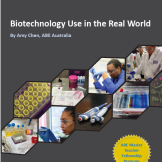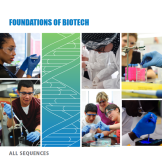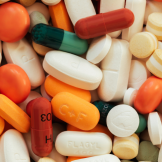Search Results for Biotech & Medicine
To browse more topics, click a topic below or try our advanced search.
 Resource (Teaching Materials, Classroom-based)
Resource (Teaching Materials, Classroom-based)Biotechnology Use in the Real World

In this project, developed by ABE Australia Master Teacher Fellow Amy Chen, students become familiar with the many ways that biotechnology is in the world around us, and how it impacts our lives, and… Read more
Class Sessions18
Appropriate AgesUpper Secondary
 Resource (Teaching Materials, Classroom-based, Pocket Lesson)
Resource (Teaching Materials, Classroom-based, Pocket Lesson)Who Decides? The Ethics of Organ Transplantation

In this pocket lesson, students learn about the process adopted in various areas of the world to decide who receives available organs. This content gives students the opportunity to explore how these… Read more
Class Sessions3Appropriate AgesUpper Secondary, Introductory
 Resource (Teaching Materials, Web-based)
Resource (Teaching Materials, Web-based)Gene Regulation of the Red Fluorescent Protein in the PARA-R Plasmid

This lesson introduces students to the concept of gene regulation, and several related topics. It covers several types of operons, including the regulation mechanism involved in Foundations of… Read more
Class Sessions11Appropriate AgesLower Secondary, Upper Secondary
 Resource (Teaching Materials, Lab-based)
Resource (Teaching Materials, Lab-based)ABE for Lower Secondary School

This lesson is a series of lower-secondary school activities modeled after the ABE Foundations of Biotech lab series. In it, younger students can explore some of the tools and techniques of… Read more
Class Sessions6–10Appropriate AgesLower Secondary
 Resource (Teaching Materials, Lab-based)
Resource (Teaching Materials, Lab-based)Quality Control Testing of Purified RFP

In this series of hands-on activities, students perform quality-control tests on the red fluorescent protein, which they created and isolated during the ABE Foundations of Biotech labs, and learn to… Read more
Class Sessions5Appropriate AgesUpper Secondary
 Resource (Teaching Materials, Web-based)
Resource (Teaching Materials, Web-based)Genetic Technologies Overview

This lesson provides an introduction to eight current topics in biotechnology, including polymerase chain reaction (PCR), DNA "fingerprinting," and genetic sequencing. The scientific principles… Read more
Class Sessions11Appropriate AgesUpper Secondary
 Resource (Teaching Materials, Classroom-based, Lab-based)
Resource (Teaching Materials, Classroom-based, Lab-based)Exploring Tools of the Biotechnology Lab: Yeast – The Living Tool

Because the cellular processes of yeast are relatively easy to manipulate, it has been extensively used as a model organism in biotechnology research. Like human cells, yeast cells have a nucleus… Read more
Class Sessions4Appropriate AgesLower Secondary
 Resource (Teaching Materials, Classroom-based)
Resource (Teaching Materials, Classroom-based)Thalassemia

In this lesson, students deepen their understanding of the relationship between scientific research in modern biology and medicine by studying the genetic basis of thalassemia, a form of hereditary… Read more
Class Sessions15Appropriate AgesUpper Secondary
 Resource (Teaching Materials, Classroom-based)
Resource (Teaching Materials, Classroom-based)Innovative Cancer Treatments

This lesson aims to engage and deepen students’ experiences and expertise in the field of “Cancer Cells” and “Innovative Therapies for recurring or difficult-to-treat cancers,” and in particular… Read more
Class Sessions15–20
Appropriate AgesUpper Secondary
 Resource (Teaching Materials, Classroom-based)
Resource (Teaching Materials, Classroom-based)Why Is Scientific Research Regulated?

This lesson covers scientific regulation and an overview of bioethics, as well as nuclear energy, gene editing, and a number of other hot-button issues that students will definitely have heard about… Read more
Class Sessions10Appropriate AgesUpper Secondary
 Resource (Teaching Materials, Classroom-based)
Resource (Teaching Materials, Classroom-based)Is It in Our Genes? Race and Health

In this companion to the ABE Exploring Precision Medicine module, students explore and compare the concepts of race and genetics, and the social and medical impact these categories may have on… Read more
Class Sessions5–10Appropriate AgesUpper Secondary
 Resource (Teaching Materials, Classroom-based)
Resource (Teaching Materials, Classroom-based)Viral Variants

This project addresses several key issues related to microorganisms, and places students in the role of CDC investigators who are studying the origins of a virus resistant to treatment. In addition,… Read more
Class Sessions8–10Appropriate AgesLower Secondary, Upper Secondary, Introductory
 Resource (Teaching Materials, Lab-based)
Resource (Teaching Materials, Lab-based)The Good, the Bad, and the Complex Part 1: The Good—Lactic Acid Bacteria

Students investigate some of the claims companies make about probiotics and learn several key techniques in biotechnology (including aseptic technique, spreading, pipetting, sterilization using a… Read more
Class Sessions5+Appropriate AgesUpper Secondary
 Resource (Teaching Materials, Lab-based)
Resource (Teaching Materials, Lab-based)What Can DNA Tell Us About Race?

This project examines issues of race and racism using a variety of scientific lenses, and debunks many widely held misconceptions. Students use a variety of techniques to look at misconceptions,… Read more
Appropriate AgesUpper Secondary
 Resource (Teaching Materials, Web-based)
Resource (Teaching Materials, Web-based)Saving a Life

A man drinks an unknown liquid and soon is found unresponsive in an emergency room. Students use bioinformatics tools to investigate what substance caused such a life-threatening response. Read more
Appropriate AgesLower Secondary
 Resource (Teaching Materials, Web-based)
Resource (Teaching Materials, Web-based)Responding to a Mystery Illness

This resource is based on real events, though the timeline and details may have been changed to allow it to be used for educational purposes. As part of an imaginary WHO team, students help determine… Read more
Appropriate AgesUpper Secondary, Advanced
 Resource (Teaching Materials, Classroom-based, Pocket Lesson)
Resource (Teaching Materials, Classroom-based, Pocket Lesson)Designing Babies with CRISPR

In this pocket lesson, students read and analyze an article exploring the process of genetic modification and the implications it can have on society. Students explore the ethics of editing embryos… Read more
Class Sessions2–3Appropriate AgesUpper Secondary, Advanced
 Resource (Teaching Materials, Lab-based)
Resource (Teaching Materials, Lab-based)Foundations of Biotech

The Foundations of Biotech labs were created to introduce students to biotech techniques and concepts; in these labs, students explore recombinant DNA technology.Sequences of these labs were designed… Read more
Class Sessions4–20
Appropriate AgesUpper Secondary, Advanced
 Resource (Lab-based)
Resource (Lab-based)Exploring Precision Medicine

Precision medicine identifies treatment and prevention strategies for a person based on their genetic, environmental, and lifestyle factors. In the Exploring Precision Medicine curriculum module,… Read more
Class Sessions11–15
Appropriate AgesUpper Secondary, Advanced
 Resource (Teaching Materials, Lab-based)
Resource (Teaching Materials, Lab-based)ABE for Lower Secondary School

This lesson is a series of lower-secondary school activities modeled after the ABE Foundations of Biotech lab series. In it, younger students can explore some of the tools and techniques of… Read more
Class Sessions6–10Appropriate AgesLower Secondary
 Resource (Teaching Materials, Lab-based)
Resource (Teaching Materials, Lab-based)Quality Control Testing of Purified RFP

In this series of hands-on activities, students perform quality-control tests on the red fluorescent protein, which they created and isolated during the ABE Foundations of Biotech labs, and learn to… Read more
Class Sessions5Appropriate AgesUpper Secondary
 Resource (Teaching Materials, Classroom-based, Lab-based)
Resource (Teaching Materials, Classroom-based, Lab-based)Exploring Tools of the Biotechnology Lab: Yeast – The Living Tool

Because the cellular processes of yeast are relatively easy to manipulate, it has been extensively used as a model organism in biotechnology research. Like human cells, yeast cells have a nucleus… Read more
Class Sessions4Appropriate AgesLower Secondary
 Resource (Teaching Materials, Lab-based)
Resource (Teaching Materials, Lab-based)The Good, the Bad, and the Complex Part 1: The Good—Lactic Acid Bacteria

Students investigate some of the claims companies make about probiotics and learn several key techniques in biotechnology (including aseptic technique, spreading, pipetting, sterilization using a… Read more
Class Sessions5+Appropriate AgesUpper Secondary
 Resource (Teaching Materials, Lab-based)
Resource (Teaching Materials, Lab-based)What Can DNA Tell Us About Race?

This project examines issues of race and racism using a variety of scientific lenses, and debunks many widely held misconceptions. Students use a variety of techniques to look at misconceptions,… Read more
Appropriate AgesUpper Secondary
 Resource (Teaching Materials, Lab-based)
Resource (Teaching Materials, Lab-based)Foundations of Biotech

The Foundations of Biotech labs were created to introduce students to biotech techniques and concepts; in these labs, students explore recombinant DNA technology.Sequences of these labs were designed… Read more
Class Sessions4–20
Appropriate AgesUpper Secondary, Advanced
 Resource (Teaching Materials, Classroom-based)
Resource (Teaching Materials, Classroom-based)Biotechnology Use in the Real World

In this project, developed by ABE Australia Master Teacher Fellow Amy Chen, students become familiar with the many ways that biotechnology is in the world around us, and how it impacts our lives, and… Read more
Class Sessions18
Appropriate AgesUpper Secondary
 Resource (Teaching Materials, Classroom-based, Pocket Lesson)
Resource (Teaching Materials, Classroom-based, Pocket Lesson)Who Decides? The Ethics of Organ Transplantation

In this pocket lesson, students learn about the process adopted in various areas of the world to decide who receives available organs. This content gives students the opportunity to explore how these… Read more
Class Sessions3Appropriate AgesUpper Secondary, Introductory
 Resource (Teaching Materials, Classroom-based, Lab-based)
Resource (Teaching Materials, Classroom-based, Lab-based)Exploring Tools of the Biotechnology Lab: Yeast – The Living Tool

Because the cellular processes of yeast are relatively easy to manipulate, it has been extensively used as a model organism in biotechnology research. Like human cells, yeast cells have a nucleus… Read more
Class Sessions4Appropriate AgesLower Secondary
 Resource (Teaching Materials, Classroom-based)
Resource (Teaching Materials, Classroom-based)Thalassemia

In this lesson, students deepen their understanding of the relationship between scientific research in modern biology and medicine by studying the genetic basis of thalassemia, a form of hereditary… Read more
Class Sessions15Appropriate AgesUpper Secondary
 Resource (Teaching Materials, Classroom-based)
Resource (Teaching Materials, Classroom-based)Innovative Cancer Treatments

This lesson aims to engage and deepen students’ experiences and expertise in the field of “Cancer Cells” and “Innovative Therapies for recurring or difficult-to-treat cancers,” and in particular… Read more
Class Sessions15–20
Appropriate AgesUpper Secondary
 Resource (Teaching Materials, Classroom-based)
Resource (Teaching Materials, Classroom-based)Why Is Scientific Research Regulated?

This lesson covers scientific regulation and an overview of bioethics, as well as nuclear energy, gene editing, and a number of other hot-button issues that students will definitely have heard about… Read more
Class Sessions10Appropriate AgesUpper Secondary
 Resource (Teaching Materials, Classroom-based)
Resource (Teaching Materials, Classroom-based)Is It in Our Genes? Race and Health

In this companion to the ABE Exploring Precision Medicine module, students explore and compare the concepts of race and genetics, and the social and medical impact these categories may have on… Read more
Class Sessions5–10Appropriate AgesUpper Secondary
 Resource (Teaching Materials, Classroom-based)
Resource (Teaching Materials, Classroom-based)Viral Variants

This project addresses several key issues related to microorganisms, and places students in the role of CDC investigators who are studying the origins of a virus resistant to treatment. In addition,… Read more
Class Sessions8–10Appropriate AgesLower Secondary, Upper Secondary, Introductory
 Resource (Classroom-based)
Resource (Classroom-based)What Can We Learn from Extreme Phenotypes?

Students learn that genetics is more complex than the simple binary relationship it is often portrayed as having. They explore how extreme phenotypes can be used to inform our understanding of drug… Read more
Class Sessions8-14Appropriate AgesUpper Secondary, Advanced
 Resource (Teaching Materials, Classroom-based, Pocket Lesson)
Resource (Teaching Materials, Classroom-based, Pocket Lesson)Designing Babies with CRISPR

In this pocket lesson, students read and analyze an article exploring the process of genetic modification and the implications it can have on society. Students explore the ethics of editing embryos… Read more
Class Sessions2–3Appropriate AgesUpper Secondary, Advanced
 Resource (Classroom-based)
Resource (Classroom-based)Clinical Trials: From Disease to Medicine

In the From Disease to Medicine module, students learn about the purpose and structure of clinical research by exploring the various phases of a clinical trial. Students investigate the… Read more
Class Sessions8–10
Appropriate AgesUpper Secondary, Advanced
 Resource (Classroom-based)
Resource (Classroom-based)Chasing Cystic Fibrosis

Students become engaged in learning about the disease cystic fibrosis (CF): they develop questions that they have about CF, its treatment, and its consequences, and then explore how they can… Read more
Class Sessions8–9Appropriate AgesUpper Secondary, Advanced
 Resource (Classroom-based, Pocket Lesson)
Resource (Classroom-based, Pocket Lesson)Changing Organ Donation with Biotechnology

In this pocket lesson, students explore the need for innovative solutions to the shortage of transplantable organs and how gene editing technologies might offer a potential solution. Read more
Class Sessions2-3Appropriate AgesUpper Secondary, Advanced
 Resource (Teaching Materials, Web-based)
Resource (Teaching Materials, Web-based)Gene Regulation of the Red Fluorescent Protein in the PARA-R Plasmid

This lesson introduces students to the concept of gene regulation, and several related topics. It covers several types of operons, including the regulation mechanism involved in Foundations of… Read more
Class Sessions11Appropriate AgesLower Secondary, Upper Secondary
 Resource (Teaching Materials, Web-based)
Resource (Teaching Materials, Web-based)Genetic Technologies Overview

This lesson provides an introduction to eight current topics in biotechnology, including polymerase chain reaction (PCR), DNA "fingerprinting," and genetic sequencing. The scientific principles… Read more
Class Sessions11Appropriate AgesUpper Secondary
 Resource (Web-based)
Resource (Web-based)Using Bioinformatics to Track Down a Rare Cause of Diabetes

Many people are aware of the main two types of diabetes: type 1 and type 2. However, few people know that there are other types of diabetes. One type occurs in pregnant women (gestational diabetes),… Read more
Appropriate AgesLower Secondary
 Resource (Teaching Materials, Web-based)
Resource (Teaching Materials, Web-based)Saving a Life

A man drinks an unknown liquid and soon is found unresponsive in an emergency room. Students use bioinformatics tools to investigate what substance caused such a life-threatening response. Read more
Appropriate AgesLower Secondary
 Resource (Teaching Materials, Web-based)
Resource (Teaching Materials, Web-based)Responding to a Mystery Illness

This resource is based on real events, though the timeline and details may have been changed to allow it to be used for educational purposes. As part of an imaginary WHO team, students help determine… Read more
Appropriate AgesUpper Secondary, Advanced
 Blog Post
Blog PostNothing Is Stopping South African ABE Learners from Pursuing Science

Listening to South African students Lesedi and Lilitha discuss their interests in science and plans to pursue medicine, it’s hard to believe they are only 15 and 16 years old. The confidence and… Read more
 Blog Post
Blog PostA Redesigned Precision Medicine Module Sparks Student Excitement

Excitement is in the air in a biology classroom in Tampa, Florida. As Mishell Thomas-King explains how her students will be trying out a new lab next quarter that lets them test their own DNA, a… Read more
 Blog Post
Blog PostAmgen Massachusetts Leader Reflects on Early Science Education

When Margaret Faul was growing up in Dublin, Ireland, she thought she had only a few career choices: doctor, teacher, accountant. Coming from a family who worked in healthcare and business, scientist… Read more
 Blog Post
Blog PostABE Site Staff Convene in U.S. to Share Experiences and Build Community

These quotes from the ABE All-Staff Meeting in May highlight the unique character of the ABE community: it is not only a community of dedicated educators, but also a group of passionate leaders… Read more
 Blog Post
Blog PostA Transformational Lab Training Day in Dublin

Sitting between two of her students on a Zoom call in early December, Clare Collins was beaming with pride. Ready for the winter holiday break, they were also eager to share their experiences about… Read more
 Blog Post
Blog PostDrug Design: Matching a Drug to Its Target

When we think of medicines, we often picture colorful capsules, pills, or liquids that cure illnesses or help us feel better. But how do these medicines go to the right places and how do they treat… Read more
 Blog Post
Blog PostA Real-World Biotech Detective

Detective work is not found only in law enforcement. Epidemiologists and data scientists all investigate what happens when a medicine enters the real world, “deciphering” everything from who receives… Read more